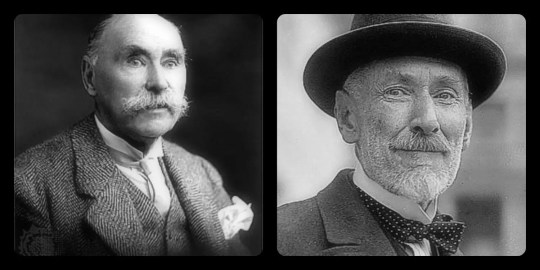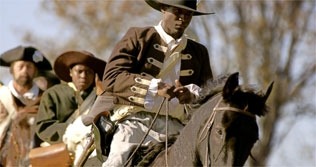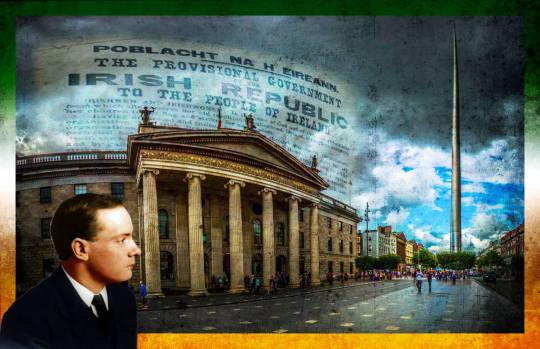#british rule
Text
#OTD in 1876 – The Society for the Preservation of the Irish Language is formed in Dublin.
“In order to de-Anglicize ourselves, we must at once arrest the decay of the language. We must bring pressure upon our politicians not to snuff it out by their racist discouragement merely because they do not themselves understand it. We must arouse some spark of patriotic inspiration among the peasantry who still use the language, and put an end to that shameful state of feeling — a…

View On WordPress
#British Rule#Douglas Hyde#Gaelic League#Gaelic Union#Horace Plunkett#Ireland#Irish language#SPIL#The Society for the Preservation of the Irish Language
34 notes
·
View notes
Text
To all the Leftist white people whining about the way the British are portrayed and discussed in Ms Marvel...
You are not supposed to feel comfortable when discussing colonisation, genocide, and atrocities.
Read that again.
Oppressed people are always told they cannot speak about their oppression. Or if they can, they have to "consider both sides", "think about historical context", anything to make the white people comfortable. Comfortable by dissociation from it, by othering it, by using cognitive dissonance to remove themselves from it.
This allows white people to nod, say "oh yes, it was terrible", then go right back to their lifestyles powered by third world suffering, international oppression, and the benefits of historical and ongoing colonialism.
If you truely believe you are Left, then you need to accept being uncomfortable when confronted with the voices of oppressed and colonised peoples. Sit with that discomfort, and listen to what is being said to you.
Sincerely,
A white British Anglo-Indian person who loved every moment of Ms Marvel and cried at the partition stories.
#ms marvel show#ms marvel series#ms marvel#ms. marvel#ms.marvel#mcu#marvel#colonialism#oppression#partition#raj india#genocide#atrocity#british rule#british empire#british colonialism#capitalism#democratic socialism
211 notes
·
View notes
Text
What US Would Be Like if America Lost the Revolution
Imagining an alternate reality where the American Revolution was lost and the United States did not gain independence is a fascinating exercise in historical speculation. While it is impossible to predict with certainty how events would have unfolded, we can explore some possible scenarios.

Continued British Rule: If the American Revolution failed, the American colonies would have remained under British rule. This would have meant that the British Crown would have continued to govern the American territories, and the American colonists would have been subject to British laws, taxes, and regulations.
Limited Autonomy: It is possible that the British government, recognizing the discontent among the colonists, might have granted them some limited autonomy or representation in the British Parliament. However, it is unlikely that the colonies would have enjoyed the same degree of self-governance as they eventually achieved through independence.
Economic Implications: Without independence, the American colonies would have remained part of the British mercantile system. This system placed restrictions on colonial trade and favored British interests. As a result, the American economy may have been more dependent on British trade, limiting opportunities for domestic industrialization and economic growth.
Slavery: The issue of slavery, which played a significant role in the lead-up to the American Revolution, would have likely continued. The British Empire abolished slavery in 1833, so it is possible that slavery may have been abolished earlier in the American colonies under British rule. However, this would have varied depending on the specific circumstances and pressures within each colony.
Manifest Destiny and Westward Expansion: The idea of Manifest Destiny, which drove westward expansion and the growth of the United States throughout the 19th century, would not have emerged in the same way. The British Empire had a different approach to territorial expansion, and it is uncertain how it would have shaped the development of the American territories.
International Relations: The geopolitical landscape would have been vastly different. Without the United States as a separate nation, the balance of power in North America and the world would have shifted. Other European powers, such as France and Spain, may have had a greater influence in the American territories.
Alternative Paths: It is important to note that the desire for independence was not limited to the American colonies alone. Other regions of the world, inspired by the American Revolution, also sought self-governance and independence. The success or failure of the American Revolution may have influenced these movements in different ways.
Remember, these scenarios are purely speculative, and countless factors could have shaped the course of history in the absence of an American victory in the Revolution. The development of the United States and the world as we know it today would have been dramatically different.
#Alternate History#American Revolution#Historical Speculation#What If#Hypothetical Scenario#British Rule#Independence#Geopolitics#Colonial America#Manifest Destiny#Slavery#International Relations#Counterfactual History#British Empire#Impact of Defeat#today on tumblr#deep thoughts#deep thinking
13 notes
·
View notes
Text
A Short Message To The Nigerian People On The Celebration Of Their October 1st Independence
October 1st is a date of great significance for Nigeria and its people as it marks the country's Independence Day. On this day in 1960, Nigeria achieved freedom from British colonial rule, becoming a sovereign nation and taking its rightful place on the world stage.
The road to independence was not easy, as it was marked by decades of struggle, sacrifice, and unwavering determination. Nigerian nationalists, led by figures such as Nnamdi Azikiwe, Obafemi Awolowo, and Ahmadu Bello, tirelessly campaigned for self-determination and the right to govern their own land. Their dedication and the unity of Nigeria's diverse ethnic groups were key factors in achieving this monumental goal.
Independence Day celebrations on October 1st are a time for Nigerians to reflect on their history, culture, and the progress made since gaining freedom. The day is marked by various events and festivities, including parades, cultural performances, and patriotic displays. It is an occasion to reaffirm national unity and pride in the rich tapestry of Nigeria's heritage.
Nigeria's independence came with great promise and hope for the future. As the most populous country in Africa, Nigeria possesses immense potential in various fields, including economics, politics, and culture. Over the years, Nigeria has made significant strides in these areas, becoming a regional leader and an influential player on the global stage.
However, challenges persist, including issues related to governance, security, and socio-economic development. Independence Day serves as a reminder of the ongoing commitment needed to address these challenges and build a brighter future for all Nigerians.
On October 1st, Nigerians not only celebrate their hard-won freedom but also renew their dedication to building a more prosperous and united nation. It is a day to honor the sacrifices of the past, celebrate the achievements of the present, and look forward to a future filled with promise and potential. The power to utilise the vast potential like the trinity such as: crude oil, iron ores, & agriculture.
October 1st is a day of great significance for Nigeria and its people. It marks the country's Independence Day, a time to celebrate freedom from colonial rule, reflect on the nation's history and culture, and renew the commitment to building a better future. Nigeria's journey since 1960 has been marked by progress and challenges, making Independence Day a momentous occasion for all Nigerians to come together in unity and hope.


#october#october 1st#independence day#nigeria#leadership#british gp 2023#british rule#fypage#trending#viralpost
6 notes
·
View notes
Text
Queen Elizabeth II ascended the British throne on February 6, 1952

#Queen Elizabeth#Britain#London is falling#rip#British rule#Queen#Queen Elizabeth II#royalty#royal family#ruler#monarchy#reign#buckingham palace#her majesty#the crown
25 notes
·
View notes
Text
Favoring the British Crown: enslaved Blacks, Annapolis, and the run to freedom [Part 1]

This watercolour sketch by Captain William Booth, Corps of Engineers, is the earliest known image of an African Nova Scotian. He was probably a resident of Birchtown. According to Booth's description of Birchtown, fishing was the chief occupation for "these poor, but really spirited people." Those who could not get into the fishery worked as labourers, clearing land by the acre, cutting cordwood for fires, and hunting in season. Image and caption are courtesy of the Nova Scotia Archives, used within fair use limits of copyright law.
In 1777, William Keeling, a 34 year old Black man ran away from Grumbelly Keeling, a slaveowner on the Eastern Shore of Virginia, which covers a very small area. [1] The Keelings were an old maritime family within Princess Anne County. William, and possibly his wife Pindar, a "stout wench" as the British described her, would be evacuated July 1783 on the Clinton ship from New York with British troops and other supporters of the British Crown ("Loyalists") likely to somewhere in Canada. [2] They were not the only ones. This article does not advocate for the "loyalist" point of view, but rather just tells the story of Blacks who joined the British Crown in a quest to gain more freedom from their bondage rather than the revolutionary cause. [3]
Reprinted from my History Hermann WordPress blog.
Black families go to freedom
There were a number of other Black families that left the newly independent colonies looking for freedom. Many of these individuals, described by slaveowners as "runaways," had fled to British lines hoping for Freedom. Perhaps they saw the colonies as a “land of black slavery and white opportunity,” as Alan Taylor put it, seeing the British Crown as their best hope of freedom. [4] After all, slavery was legal in every colony, up to the 1775, and continuing throughout the war, even as it was discouraged in Massachusetts after the Quock Walker decision in 1783. They likely saw the Patriots preaching for liberty and freedom as hypocrites, with some of the well-off individuals espousing these ideals owning many humans in bondage.
There were 26 other Black families who passed through Annapolis on their way north to Nova Scotia to start a new life. When they passed through the town, they saw as James Thatcher, a Surgeon of the Continental Army described it on August 11, 1781, "the metropolis of Maryland, is situated on the western shore at the mouth of the river Severn, where it falls into the bay."
The Black families ranged from 2 to 4 people. Their former slavemasters were mainly concentrated in Portsmouth, Nansemond, Crane Island, Princess Ann/Anne County, and Norfolk, all within Virginia, as the below chart shows:

Not included in this chart, made using the ChartGo program, and data from Black Loyalist, are those slaveowners whose location could not be determined or those in Abbaco, a place which could not be located. [5] It should actually have two people for the Isle of Wight, and one more for Norfolk, VA, but I did not tabulate those before creating the chart using the online program.
Of these slaveowners, it is clear that the Wilkinson family was Methodist, as was the Jordan family, but the Wilkinsons were "originally Quakers" but likely not by the time of the Revolutionary War. The Wilkinson family was suspected as being Loyalist "during the Revolution" with “Mary and Martha Wilkinsons (Wilkinson)... looked on as enemies to America” by the pro-revolutionary "Patriot" forces. However, none of the "Wilkinsons became active Loyalists." Furthermore, the Willoughby family may have had some "loyalist" leanings, with other families were merchant-based and had different leanings. At least ten of the children of the 26 families were born as "free" behind British lines while at least 16 children were born enslaved and became free after running away for their freedom. [6]
Beyond this, it is worth looking at how the British classified the 31 women listed in the "Book of Negroes" compiled in 1783, of which Annapolis was one of the stops on their way to Canada. Four were listed as "likely wench[s]" , four as "ordinary wench[s]", 18 as "stout wench[s]", and five as other. Those who were "likely wench[s]" were likely categorized as "common women" (the definition of wench) rather than "girl, young woman" since all adult women were called "wench" without much exception. [7] As for those called "ordinary" they would belong to the "to the usual order or course" or were "orderly." The majority were "stout" likely meaning that they were proud, valiant, strong in body, powerfully built, brave, fierce, strong in body, powerfully built rather than the "thick-bodied, fat and large, bulky in figure," a definition not recorded until 1804.
Fighting for the British Crown

Tye Leading Troops as dramatized by PBS. Courtesy of Black Past.
When now-free Blacks, most of whom were formerly enslaved, were part of the evacuation of the British presence from the British colones from New York, leaving on varying ships, many of them had fought for the British Crown within the colonies. Among those who stopped by Annapolis on their way North to Canada many were part of the Black Brigade or Black Pioneers, more likely the latter than the former.
The Black Pioneers had fought as part of William Howe's army, along with "black recruits in soldiers in the Loyalist and Hessian regiments" during the British invasion of Philadelphia. This unit also provided "engineering duties in camp and in combat" including cleaning ground used for camps, "removing obstructions, digging necessaries," which was not glamorous but was one of the only roles they played since "Blacks were not permitted to serve as regular soldiers" within the British Army. While the noncommissioned officers of the unit were Black, commissioned officers were still white, with tank and file composed mainly of "runaways, from North and South Carolina, and a few from Georgia" and was allowed as part of Sir Henry Clinton's British military force, as he promised them emancipation when the war ended. The unit itself never grew beyond 50 or go men, with new recruits not keeping up from those who "died from disease and fatigue" and none from fighting in battle since they just were used as support, sort of " garbage men" in places like Philadelphia. The unit, which never expanded beyond one company, was boosted when Clinton issued the "Phillipsburgh Proclamation," decreeing that Blacks who ran away from "Patriot" slavemasters and reached British lines were free, but this didn't apply to Blacks owned by "Loyalist" slavemasters or those in the Continental army who were "liable to be sold by the British." In December 1779, the Black Pioneers met another unit of the same type, was later merged with the Royal North Carolina Regiment, and was disbanded in Nova Scotia, ending their military service, many settling in Birchtown, named in honor of Samuel Birch, a Brigadier General who provides the "passes that got them out of America and the danger of being returned to slavery." Thomas Peters, Stephen Bluke, and Henry Washington are the best known members of the Black Pioneers.
The Black Brigade was more "daring in action" than the Black Pioneers or Guides. Unlike the 300-person Ethiopian Regiment (led by Lord Dunmore), this unit was a "small band of elite guerillas who raided and conducted assassinations all across New Jersey" and was led by Colonel Tye who worked to exact "revenge against his old master and his friends" with the title of Colonel a honorific title at best. Still, he was feared as he raided "fearlessly through New Jersey," and after Tye took a "musket ball through his wrist" he died from gangrene in late 1780, at age 27. Before that happened, Tye, born in 1753, would be, "one of the most feared and respected military leaders of the American Revolution" and had escaped to "New Jersey and headed to coastal Virginia, changing his name to Tye" in November 1775 and later joined Lord Dunmore, The fighting force specialized in "guerilla tactics and didn’t adhere to the rules of war at the time" striking at night, targeting slaveowners, taking supplies, and teaming up with other British forces. After Tye's death, Colonel Stephen Blucke of the Black Pioneers replaced him, continuing the attacks long after the British were defeated at Yorktown.
After the war
Many of the stories of those who ended up in Canada and stopped in Annapolis are not known. What is clear however is that "an estimated 75,000 to 100,000 black Americans left the 13 states as a result of the American Revolution" with these refugees scattering "across the Atlantic world, profoundly affecting the development of Nova Scotia, the Bahamas, and the African nation of Sierra Leone" with some supporting the British and others seized by the British from "Patriot" slaveowners, then resold into slavery within the Caribbean sea region. Hence, the British were not the liberators many Blacks thought them to be.Still, after the war, 400-1000 free Blacks went to London, 3,500 Blacks and 14,000 Whites left for Nova Scotia and New Brunswick, where Whites got more land than Blacks, some of whom received no land at all. Even so, "more than 1,500 of the black immigrants settled in Birchtown, Nova Scotia," making it the largest free Black community in North America, which is why the "Birchtown Muster of Free Blacks" exists. Adding to this, these new Black refugees in London and Canada had a hard time, with some of those in London resettled in Sierra Leone in a community which survived, and later those from Canada, with church congregations emigrating, "providing a strong institutional basis for the struggling African settlement." After the war, 2,000 white Loyalists, 5,000 enslaved Blacks, and 200 free Blacks left for Jamaica, including 28 Black Pioneers who "received half-pay pensions from the British government." As for the Bahamas, 4,200 enslaved Blacks and 1,750 Whites from southern states came into the county, leading to tightening of the Bahamian slave code.
As one historian put, "we will never have precise figures on the numbers of white and black Loyalists who left America as a result of the Revolution...[with most of their individual stories are lost to history [and] some information is available from pension applications, petitions, and other records" but one thing is clear "the modern history of Canada, the Bahamas, and Sierra Leone would be greatly different had the Loyalists not arrived in the 1780s and 1790s." This was the result of, as Gary Nash, the "greatest slave rebellion of North American slavery" and that the "high-toned rhetoric of natural rights and moral rectitude" accompanying the Revolutionary War only had a "limited power to hearten the hearts of American slave masters." [8]
While there are varied resources available on free Blacks from the narratives of enslaved people catalogued and searchable by the Library of Virginia, databases assembled by the New England Historic Genealogical Society or resources listed by the Virginia Historical Society, few pertain to the specific group this article focuses on. Perhaps the DAR's PDF on the subject, the Names in Index to Surry County Virginia Register of Free Negroes, and the United Empire Loyalists Association of Canada (UELAC) have certain resources.
While this does not tell the entire story of those Black families who had left the colonies, stopping in Annapolis on the way, in hopes of having a better life, it does provide an opening to look more into the history of Birchtown, (also see here) and other communities in Canada and elsewhere. [9]
© 2016-2023 Burkely Hermann. All rights reserved.
#british crown#british rule#british royalty#annapolis#enslaved people#enslavement#black history#nova scotia#birchtown#fisheries#slaveowners#american revolution#revolutionary war#slavery#book of negroes#1800s#1780s#colonel tye#lord dunmore#canada#loyalists
4 notes
·
View notes
Text
Toy Train - One of the few good thing about the years of British Rule in India!

2 notes
·
View notes
Text
0 notes
Text
Dadhikando Mela - A historic protest against the British rule going back more than 100 years ago
It was 1890 and a group of revolutionaries decide to come up with a unique way to protest, they organised a religious fair. Any kind of gathering was prohibited under the British rule. But these revolutionaries were confident that a religious mela will not be objected to by the British. They also calculated that once this religious procession becomes popular, they will get massive public support.…

View On WordPress
0 notes
Text
british friend: what are you making that face for? are you having a laugh?
me, at a restaraunt: guys I think im gonna have a stroke
british friend: have a stroke? here at this restaurant mate? crikey could you not pick a better time for a wank?
760 notes
·
View notes
Text
#OTD in 1916 – Easter Rising Dublin | Day 4.
It is the fourth day of the Easter Rising and the remaining rebels are under constant attack. The GPO and Four Courts are being blitzed with machine gun and rifle fire, and large parts of Sackville Street (O’Connell Street) are up in flames.
As British authorities come to terms with the situation in Dublin, fierce street to street fighting takes place in parts of Dublin. James Connolly is…

View On WordPress
#16th Irish Division#1916 Easter Rising#Battle of Hulluch#British Army#British Rule#Capel Street#Cathal Brugha#Day Four#Dublin#Eamonn Ceannt#Easter Rising#Germany#GPO#Home Rule#Ireland#Irish Volunteers#James Connolly#John Redmond#Mount Street bridge#O&039;Connell Street#Sackville Street#South Dublin Union#WWI
6 notes
·
View notes
Text
Oh Captain, my captain!
Oh Captain, my captain!
https://abcnews.go.com/GMA/News/queen-elizabeth-ii-dies-funeral-coronation/story?id=88971819
How does one grieve the loss of such a head of state?
I’ve only ever known about the Queen–too young to appreciate anyone before her, uncertain of the following act. I feel at sea without her.
My parents took me to grow up in the USA and, though I remained a Canadian patriot and fled north as soon as I…

View On WordPress
0 notes
Text
Free tree speak काव्यस्यात्मा 1291
"इस बाग़ का फूल"
-© कामिनी मोहन पाण्डेय।

इस बाग़ का फूल गोलियों से छलनी हुआ था,
चीख़-पुकार सुनकर गगन कम्पित हुआ था।
¤
ख़ून से लथपथ बाग़ आज भी पड़ा हुआ है,
दाग़ देखकर रोता हैं दिल आँसू थमा हुआ है।
¤
क्यूँ आह नहीं सुनी जो तड़तड़ गोलियाँ बरसाता था,
निहत्थे बच्चों, बूढ़ों, महिलाओं को मार गिराता था।
¤
हत्यारा जनरल डायर अहंकार से इतराता था,
कहा रास्ता संकरा था नहीं तो मैं तोप चलवाता था।
¤
रौलेट का विरोध जालियाँवाला बाग हत्याकाण्ड कहलाता है,
ब्रिटिश शासन का कलंक हिन्दुस्तान भूल नहीं पाता है।
¤
छह सप्ताह के कोमल बालक मरे यहाँ गोली खाकर,
वृद्ध, महिलाएँ, कोमल बच्चे मरे तड़प-तड़पकर।
¤
बाग़ में मरने वालों ने बलिदान कर डाला,
ब्रिटिश शासन के अंत का प्रारम्भ कर डाला।
¤
पुष्प चढ़कर दीया जलाकर तड़पकर कहता हूँ,
स्वतंत्रता हैं सबसे बड़ी चीज़ हर मनुष्य से कहता हूँ।
-© कामिनी मोहन पाण्डेय।
#kaminimohanspoetry#kavyasadhana काव्यस्यात्मा#kaminimohansworld#poetry#kaminimohan#साधना आराधना#hindi#काव्यस्यात्मा#काव्य#poets on tumblr#british rule
1 note
·
View note
Link
#westernization#education#education system#india#europe#globalization#growth#constitution#british rule#economy#children#higher education#scientificrevolution
0 notes
Text
Constitutional Development of India
Constitutional Development of India
Constitutional Development of India
Constitutional Development of India :- The major events of the changes in the constitution during British rule (which provided the legal basis for the functioning and organization of administration in British-ruled India) are given below in chronological order.
Regulating Act 1773
This was the first step taken by the British government to control and…

View On WordPress
#Battle of Buxar in 1764 AD#Battle of Plassey in 1757 AD#British government to control and regulate#British rule#Calcutta in 1774 AD#Constitutional Development of India#functioning and organization of administration in British-ruled India#Gupta Committee#Lord Warren Hastings#military and civil administration#Supreme Court#The East India Company
0 notes
Text
Skeletons of 1857 Revolt: মিলল সিপাহি বিদ্রোহে অংশ নেওয়া প্রায় তিনশো ভারতীয় সেনার দেহাবশেষ
Skeletons of 1857 Revolt: মিলল সিপাহি বিদ্রোহে অংশ নেওয়া প্রায় তিনশো ভারতীয় সেনার দেহাবশেষ
নিজস্ব প্রতিবেদন: ভারতে সিপাহি বিদ্রোহ এক তাৎপর্যপূর্ণ ঘটনা। গোটা ভারত সেই প্রথম ব্রিটিশ শাসনের বিরুদ্ধে গর্জে উঠেছিল। হঠাৎই একটি ঘটনার জেরে সেই বিদ্রোহে অংশ নেওয়া সেনারা আরও একবার স্মরণীয় হলেন।
সম্প্রতি পাঞ্জাবে সিপাহি বিদ্রোহে অংশ নেওয়া ২৮২ সেনার দেহাবশেষ উদ্ধার করা হয়েছে। দেহাবশেষগুলি পাঞ্জাবের অমৃতসরের কাছে অজনালা শহরের এক ধর্মীয় স্থাপনার নীচে খননের সময়ে, মতান্তরে কুয়োর নীচ থেকে পাওয়া…
View On WordPress
#1857 revolt#anthropologist#Bihar#British rule#Chandigarh#eastern part of Bengal#Gangetic plain#India#Indian Mutiny#J.S.Sehrawat#latest study#Odisha#Panjab University#Sepoy Mutiny#skeletons#Uttar Pradesh
1 note
·
View note